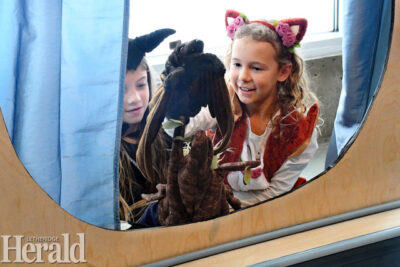Nature centre dispels bat myths
By Justin Seward - Lethbridge Herald on November 1, 2023.
 Herald photo by Justin Seward
Hannah Lampman and Kaitlyn Mikilak provide a bat puppet show during Batstravaganza this past weekend at the Southern Alberta Art Gallery.
Herald photo by Justin Seward
Hannah Lampman and Kaitlyn Mikilak provide a bat puppet show during Batstravaganza this past weekend at the Southern Alberta Art Gallery.The Southern Alberta Art Gallery teamed up with the Helen Schuler Nature Centre and the Alberta Community Bat Program to bring Batstravaganza to the art gallery on Saturday.
The afternoon allowed participants to learn how bats play a vital role in the community as well as enjoy games and crafts and candy.
“We’re celebrating International Bat Week, which is a week throughout the world to celebrate bats and their importance to all sorts of things – ecology and people ,” said Jessica Deacon-Rogers, Nature Centre education program coordinator.
“And so the Nature Centre is here today to celebrate the amazing bats we have here in southern Alberta, teaching people a little bit more about them. Bats are really often misunderstood, there’s lots of myths about them and so dispelling some of those common myths about bats.”
Deacon-Rogers often fields the question of if bats are flying at you, are they really trying to bite you or fly at you.
“Bats catch things like moths and mosquitoes at night,” she said.
“And so when bats are flying around trying to catch moths and mosquitoes, mosquitoes in particular often bite people, and so it may be perceived that a bat’s flying towards you and maybe trying to attack you.
“When they’re actually flying after insects that are in the air around your head. Bats are extremely agile and good at flying and so they won’t actually fly into you and they’re not chasing you. It’s just they’re trying to catch food that is flying close to you and those insects that are nighttime insects.”
Nine species of bats live in Alberta.
“They’re doing research right now about bats because there’s actually very little known about bat species,” said Deacon-Rogers.
“They’re really hard to study because they come out at night, they’re hard to see, they’re hard to identify and until fairly recently it was really hard to capture echolocation recordings because we can’t hear bats. The pitch that they make sound at is so high that we can’t hear it with our ears and so it’s only recently there’s been technology that’s being used, they’re echo meter readers that are put out, and then they can record sounds in different areas. And scientists can then take those recordings and see what different types of bats are in the area.”
The river valley and storm lakes are locations where bats hang out in the area in the spring and summer, while at this current time they’re in hibernation and others migrate south.
Bats tend to be imperilled in North America.
“White-Nose Syndrome is something that people are becoming more familiar with,” she said.
“It is something that impacts bat species and it has started to spread to western Canada. It used to be something that was a bit more further south and east, and so, White-Nose fungus is something that grows on bats when they are in hibernation and it has been killing thousands and thousands and thousands of bats in North America.”
Deacon-Rogers had read that you’re more likely to get rabies from a dog than a bat.
“Just because we’re around dogs a lot more,” she said.
“Most mammals carry rabies in different forms. So it’s not just bats that are rabies carriers.”
SAAG’s program and event coordinator Heather Kehoe’s favourite misconception is that bats are considered uncharismatic species.
“There’s charismatic species that are easy to kind of raise money for and promote as important endangered species and uncharismatic species, which sometimes have a bit of a reputation for being creepy and crawly,” said Kehoe.
“I think the (Gabi Dao) exhibition and the work that Helen Schuler does really highlights that bats are very adorable creatures that are very useful and very necessary.”
22-21




